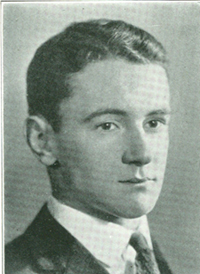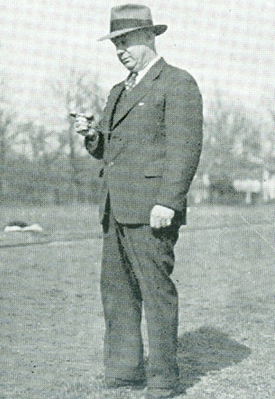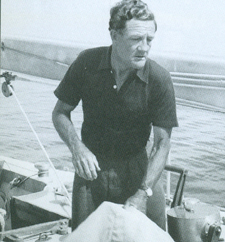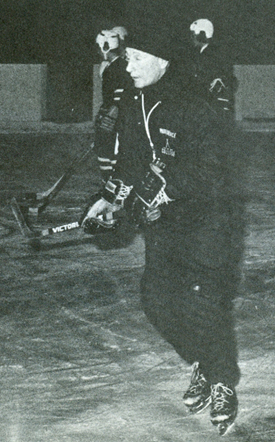The Founders Hall
The Founders Hall was established in the Athletics Hall of Fame's inaugural year as a one-time induction class meant to recognize those "indisputible" athletes and coaches who have made a tremendous impact on Hill athletics throughout the School's history. The Founders Hall includes the following 17 members:
Frank Bissell '33
 |
Frank Bissell was captain of the undefeated 1932 football team and the inter-form wrestling champion during his sixth form year at The Hill, as wrestling was not yet a varsity sport at The Hill, and then went on to have an outstanding wrestling career at The University of Michigan. He is best remembered for his coaching ability, however. He became the head wrestling coach in 1947, and by his retirement in 1973 he had amassed a career record of 243-66-5 and guided the wrestling team to 17 Prep National Championships. During his tenure, 44 wrestlers claimed individual national championships, and six were named the Outstanding Wrestler at Nationals. He prepared his squads for post-season tournaments by scheduling top public school and college freshman teams during the regular season. |
His success as a coach didn’t depend on recruiting but rather on his ability to create wrestlers, in many cases out of boys lacking any identifiable athletic talent. Some of those boys who entered the school as unathletic third formers became champions as sixth formers. Frank instilled in his boys a mindset that doing anything less than their best was not enough and created a championship culture. He also was the head football coach from 1953 until 1964, leading the 1953, 1955, and 1957 teams to undefeated seasons. Frank Bissell was elected into the National Wrestling Hall of Fame in 2012.
Sabin Carr '24
 |
Sabin Carr holds the unique distinction of having been a first-team All-American in his second best event, the javelin throw, but not in his best event, the pole vault. As a fifth former, Carr set a school and state record in the javelin with a throw of 173-1, making him the ninth farthest thrower in U.S. high school history at that point in time. He had been a good pole vaulter, but in 1924 he blossomed in the vault, setting three state records and eventually clearing 12-9 to win the Eastern Olympic Trials, becoming the third-highest high school vaulter in U.S. history in the process. His school record in the pole vault stood for 38 years. Sabin continued to excel in the pole vault throughout his collegiate years, and on May 28, 1927 he set the world record in the event, becoming the first person ever to clear 4.27 meters (14 feet), which was considered a major milestone at that point using poles much less flexible and forgiving than the poles used today. He qualified for the 1928 Olympics and won the gold medal in the pole vault. |
Henry Colbath
 |
Henry Colbath coached varsity track from 1910-1952, a span unrivaled by any other coach at The Hill. For the first 20 years, Michael Sweeney was active and the coach of some events. His name often eclipsed Henry’s but as the records show, Henry was one of the most successful coaches in the school’s history. He produced many championship teams and winners of the Interscholastics. He developed individuals who became record-breakers of Olympians. Some of his greatest performers were developed from mediocrity or even complete inexperience. To Henry, track was more than a competitive sport; it was something intensely human and personal. He had an unfailing geniality and was able to give self-confidence to those who were struggling. Through his guidance many boys found themselves, or found a real place in the school. As students and alumni they responded to the “Coach” in kind. |
He spent his final years as the School's alumni director and was able to re-connect many alumni to the School, as he was well-remembered by generations of alumni. Memorials to Henry include the Colbath Lecture Room in the Science Building; the chair of the science department is named in his honor; and the track is named after him.
Briggs Cunningham '26
 |
Briggs Cunningham is best known for his sailing and race car driving prowess. He learned to sail at the age of six, and at age 17 joined the Star Class racing fleet at the Pequot Yacht Club in Southport, Conn. He is most known for sailing in the 1958 America’s Cup races when he skippered the 12-meter sloop, Columbia, and was victorious in defending the Cup against a British Challenger. He continued to sail the Columbia through the 1960s as a member of the New York Yacht Club and during that time developed a “Cunningham,” which is a device that adjusts sailboat tension. Briggs’ interest in race cars began after attending the World’s Fair. |
He raced several times in the 24 hour race at Le Mans, and in 1951 entered the race with the Cunningham CR-4, a car he designed and built, which was hailed as America’s first sports car. He and his racing partner placed fourth in the 1952 race. He was inducted into the America’s Cup Hall of Fame in 1993; the Motor Sports Hall of Fame in 2003; and the Sports Car Club of America Hall of Fame in 2010. He also was generous benefactor of The Hill, providing major funds for the Cunningham Pool, Bissell Wrestling Room, and Pine Court faculty village.
Thomas Eccleston, Jr.
 |
Tom Eccleston, Jr. was a well-known name in the hockey community before he arrived at The Hill. He founded the ice hockey program in Burrillville, Rhode Island in the late 1930s and coached there until he moved onto Providence College, where he was head coach from 1956-64. He compilied a career record of 94-72-5 at Providence, and in 1964 he was named the NCAA Coach of the Year after guiding the Friars to the NCAA Championship game. He arrived at The Hill in 1972 and transformed the hockey program. Prior to his arrival, the hockey team had been good, but was unable to consistently compete with the cold-weather New England schools, and therefore was not considered a New England hockey program. Tom used his connections from Rhode Island and his college coaching experience to attract high end players to The Hill and quickly transformed the hockey program into one that could compete with New England's best year after year. |
He quickly became known for instilling a strong sense of discipline in his players that was instrumental in the team truly playing as a team and achieving strong results. He retired at the conclusion of the 1982-83 season having amassed a career record of 185-57-12 at The Hill, and six of the 11 teams he coached at Hill are in the Trophy Room.
Clarence Fincke 1893
 |
At The Hill, Clare played in the backfield in football and shortstop and pitcher in baseball. Upon graduation from The Hill, the New York Times declared he was one of the three best prep football players that year. He did not play tennis at Hill, but he won many tennis championships throughout New England during the summers. At Yale, he played third base and in football he was the quarterback, but in key situations he played fullback. During his senior year at Yale, he was named to the Walter Camp College Football All-American team; keep in mind, this was in the day when only 11 payers were elected to the team. He was popular among the Yale student body. He was voted the handsomest man in his Yale class and the most popular. Upon his graduation in 1897, Clare was voted the member of his class who had done the most for Yale. After graduating from Yale, Clare spent a few years coaching football at The Hill. He then went into banking where he rose to president and CEO of the Greenwich Savings Bank in New York. |
He was a trustee of The Hill. His greatest contribution to The Hill came in 1920 when the Alumni bought the School from the Meigs family. Through him, the alumni were able to secure the loans needed to buy the school.